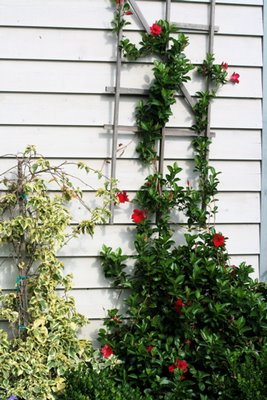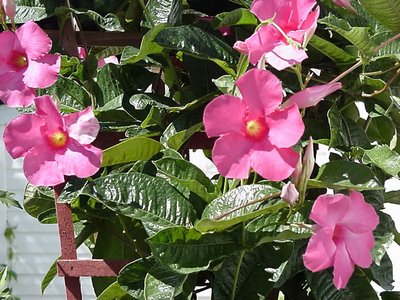 The mandevilla was so beautiful I could not leave it out to freeze. (Brought Phoebe inside, too). I sighed and grunted the plant into the greenhouse for a long winter of cutting back its wild tendrils, spraying it for aphid and whitefly, and dumping two gallons of water on it every other day. Urrrrgggh. I put it in the biggest pot I own (which also happens to be the upper size limit of what I can lift, not coincidentally), and it completely dominated the greenhouse all winter, cutting sun for everyone else. It wound its long tendrils around every plant within six feet of it, and I had to keep slashing it back. I cursed it and wished I had thought to root cuttings in the summer of 2006, so I wouldn't have to house that 60-pound, eight-foot-tall monster in my tiny Garden Pod all winter long. I had found this plant at the Greenbrier Nursery in West Virginia, and I was loath to lose that wonderful genetic material. It was the first red mandevilla I'd seen. By about January, to my great surprise and delight, I had two tiny cuttings throwing out roots, and after a winter in the greenhouse and a summer outdoors, they're just now coming into maturity, putting out delicious red blossoms. Come the first of May 2007, I just about broke my back getting the mother plant out of its pot, and I put it right into an enormous hole I dug in the ground next to the front door, where it is putting on a spectacular show and climbing a trellis up the front of the house. Thank you, darling. You've been an asset, overall.
The mandevilla was so beautiful I could not leave it out to freeze. (Brought Phoebe inside, too). I sighed and grunted the plant into the greenhouse for a long winter of cutting back its wild tendrils, spraying it for aphid and whitefly, and dumping two gallons of water on it every other day. Urrrrgggh. I put it in the biggest pot I own (which also happens to be the upper size limit of what I can lift, not coincidentally), and it completely dominated the greenhouse all winter, cutting sun for everyone else. It wound its long tendrils around every plant within six feet of it, and I had to keep slashing it back. I cursed it and wished I had thought to root cuttings in the summer of 2006, so I wouldn't have to house that 60-pound, eight-foot-tall monster in my tiny Garden Pod all winter long. I had found this plant at the Greenbrier Nursery in West Virginia, and I was loath to lose that wonderful genetic material. It was the first red mandevilla I'd seen. By about January, to my great surprise and delight, I had two tiny cuttings throwing out roots, and after a winter in the greenhouse and a summer outdoors, they're just now coming into maturity, putting out delicious red blossoms. Come the first of May 2007, I just about broke my back getting the mother plant out of its pot, and I put it right into an enormous hole I dug in the ground next to the front door, where it is putting on a spectacular show and climbing a trellis up the front of the house. Thank you, darling. You've been an asset, overall. There it lives and thrives, and there it will die come November, because I have these two gorgeous little starts from it, who have promised not to dominate the greenhouse the way their mother did. I love this plant so much that I'm also layering it, burying low-hanging stems in moist soil. Those buried sections should put out roots by fall, and then I can cut them off the mother plant. This is one of the great joys of gardening, and Bill likes to say it's my only vice: plant propagation. What I'm going to do with the starts come October is anybody's guess. Most of the people I'd give it to don't own greenhouses. Given the growth potential of this tropical vine, I'll probably be cursing those cuttings all through the winter of 2007, too.
There it lives and thrives, and there it will die come November, because I have these two gorgeous little starts from it, who have promised not to dominate the greenhouse the way their mother did. I love this plant so much that I'm also layering it, burying low-hanging stems in moist soil. Those buried sections should put out roots by fall, and then I can cut them off the mother plant. This is one of the great joys of gardening, and Bill likes to say it's my only vice: plant propagation. What I'm going to do with the starts come October is anybody's guess. Most of the people I'd give it to don't own greenhouses. Given the growth potential of this tropical vine, I'll probably be cursing those cuttings all through the winter of 2007, too.This plant was formerly in the genus Dipladenia, along with a pink variant which I also grow. Now, though they've put it in the genus Mandevilla, where it's called M. sanderi. The other Mandevilla is M. amabilis, sometimes called Chilean or Brazilian jasmine. The most frequently grown variety of M. amabilis is "Alice Dupont," boasting enormous, fragrant pink flowers and quilted, rugose leaves,
 unlike the sweet, shiny dark green leaves of M. sanderi. There's no denying that Alice Dupont puts on a spectacular show. I've grown them for years, and always used to plant one for my mother, where people would stop in front of her house to ask her what it was. I give them to my mother-in-law every year, too, and she loves them. This vine loves the cruel humidity and heat of Virginia and Ohio summers, though like mine, it dies at the first frost. It's much more a vine than a shrub, growing in a straight line if you don't cut it back.
unlike the sweet, shiny dark green leaves of M. sanderi. There's no denying that Alice Dupont puts on a spectacular show. I've grown them for years, and always used to plant one for my mother, where people would stop in front of her house to ask her what it was. I give them to my mother-in-law every year, too, and she loves them. This vine loves the cruel humidity and heat of Virginia and Ohio summers, though like mine, it dies at the first frost. It's much more a vine than a shrub, growing in a straight line if you don't cut it back.Of the two mandevillas, I now prefer to grow the shiny-leaved red-flowered M. sanderi, because it's much less prone to attacks by whitefly and red spider mite. It also has a much more compact growth habit, gorgeous shiny deep forest-green leaves, and dark red flowers that just can't be beat for beauty.
There is one more thing I love about this plant, but I'll tell you about that tomorrow. I seem to have gone on a bit long about mandevillas. It's going to be a long winter in the greenhouse, with three to bring in!






5 comments:
Oh wow! Look at that red Mandevilla! Would you be interested in selling a few cutting of it?
Thanks,
Michelle
sunshine@camtel.net
I recently purchased a Alice Dupont plant - it's dark leaves and pink flower was unique.
We brought it in the house for the Winter, just trimming the extensions - hopefully it will last. The nursery where I got it from said it prefers drier soil, not sure if I was reading was correct, but a reader said it drank every other day 2 gallons... thought plants in general don't like wet feet.
Hi, Brian.
Plants which are dormant and not growing actively generally resent being overwatered. So a mandevilla brought inside for the winter will need to be kept on the dry side, definitely. I wish you luck. I have never found Alice DuPont to be very tolerant of dry heat and lower light levels found in most houses in winter. I'd cut it back pretty severely and keep it sprayed for pests, and just hope to keep it alive until spring. I wouldn't expect much bloom unless you've got a sunroom or greenhouse.
Just bought 5 red mandevilla at Lowes and potted them into one large pot as they were only $1 each and raggedy looking when we purchased. A week of TLC and they were back to filling out the pot, showing an abundant amount of blooms and now I've added a tomato cage to train the vines and shoots. It is truly an amazing plant, don't have a greenhouse but wanted ideas to keep it through winter? any thoughts?
Hi Oomer,
Good score on the red mandevillas. This is the time of year for bargains, for sure. Indoors keeping--south window, full sun, keep them sprayed regularly for aphids and whitefly, keep them a bit dry to avoid root rot, and hope for the best. Take cuttings, put them in soil and water and see what roots (use rooting hormone powder on them). Sometimes it's just easier to buy them each spring. it really depends on your light situation.
Post a Comment